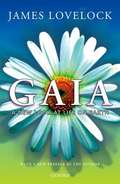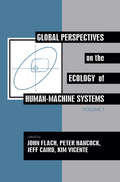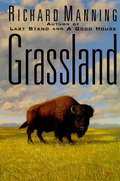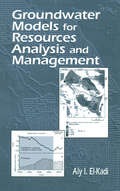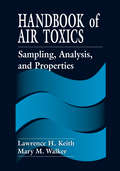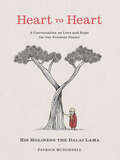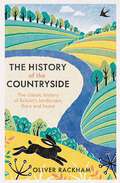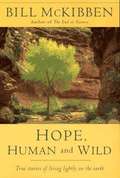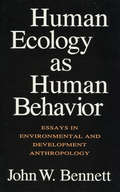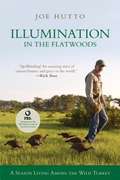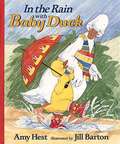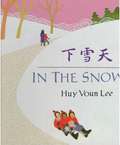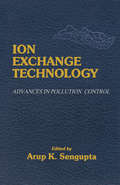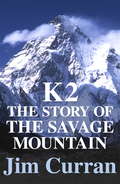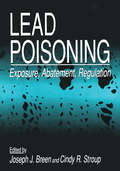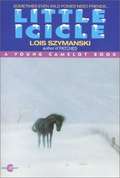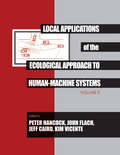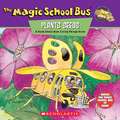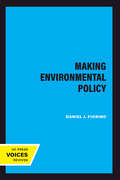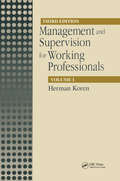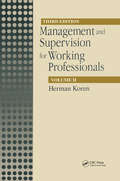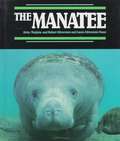- Table View
- List View
Gaia: A New Look at Life on Earth
by James LovelockIn this classic work that continues to inspire its many readers, James Lovelock deftly explains his idea that life on earth functions as a single organism. Written for the non-scientist, Gaia is a journey through time and space in search of evidence with which to support a new and radically different model of our planet. In contrast to conventional belief that living matter is passive in the face of threats to its existence, the book explores the hypothesis that the earth's living matter-air, ocean, and land surfaces-forms a complex system that has the capacity to keep the Earth a fit place for life. Since Gaia was first published, many of Jim Lovelock's predictions have come true, and his theory has become a hotly argued topic in scientific circles. Here, in a new Preface, Lovelock outlines his present state of the debate.
Global Perspectives on the Ecology of Human-Machine Systems (Resources for Ecological Psychology Series)
by John Flach, Peter Hancock, Jeff Caird and Kim VicenteThere is a growing consensus in the human factors/ergonomics community that human factors research has had little impact on significant applied problems. Some have suggested that the problem lies in the fact that much HF/E research has been based on the wrong type of psychology, an information processing view of psychology that is reductionistic and context-free. Ecological psychology offers a viable alternative, presenting a richer view of human behavior that is holistic and contextualized. The papers presented in these two volumes show the conceptual impact that ecological psychology can have on HF/E, as well as presenting a number of specific examples illustrating the ecological approach to human-machine systems. It is the first collection of papers that explicitly draws a connection between these two fields. While work in this area is only just beginning, the evidence available suggests that taking an ecological approach to human factors/ergonomics helps bridge the existing gap between basic research and applied problems.
Grassland: The History, Biology, Politics, and Promise of the American Prairie
by Richard ManningThe author, an award-winning journalist and nature writer, looks at the grasslands of the American West and Midwest, tracing the region from pre-history to the present. He discusses attempts to control the land and efforts to restore native grasses and wild herds of buffalo, and visits Ted Turner's progressive and controversial Montana ranch. Annotation c. by Book News, Inc., Portland, Or.
Groundwater Models for Resources Analysis and Management
by Aly I. El-KadiWritten by renowned experts in the field, this book assesses the status of groundwater models and defines models and modeling needs in the 21st century. It reviews the state of the art in model development and application in regional groundwater management, unsaturated flow/multiphase flow and transport, island modeling, biological and virus transport, and fracture flow. Both deterministic and stochastic aspects of unsaturated flow and transport are covered. The book also introduces a unique assessment of models as analysis and management tools for groundwater resources. Topics covered include model vs. data uncertainty, accuracy of the dispersion/convection equation, protocols for model testing and validation, post-audit studies, and applying models to karst aquifers.
Handbook of Air Toxics: Sampling, Analysis, and Properties
by Lawrence H. Keith Mary WalkerThe Handbook of Air Toxics compiles, defines, and clarifies several methods and concepts of airborne toxic substances found in the environment. This comprehensive reference helps regulators, consultants, and other environmental professionals meet the challenges of sampling and analysis, emissions reductions, and health and safety issues related to human exposure. It is an important reference addressing the ongoing concern about the consequences of air pollution, and the implementation and modification of the Environmental Protection Agency's (EPA) Clean Air Act.Some of the methods described in the Handbook of Air Toxics include fluorescence, thermal desorption, selected ion monitoring, ion chromatography, light microscopy, specific electrode analysis, titration, colorimetry, atomic absorption, and spectrophotometry. It also covers the use of isokinetic sampling trains, midget impingers, carbon molecular sieves, and sampling canisters in the analysis of air toxics. The Handbook also contains recommendations from the EPA for analytical methods for those air toxics where methods do not already exist and provides advance information on future method development by the EPA.
Heart to Heart: A Conversation on Love and Hope for Our Precious Planet
by Dalai Lama Patrick McDonnellFrom His Holiness the Dalai Lama and Mutt’s cartoonist and award-winning author Patrick McDonnell comes a powerful and timely gem of a book on how to heal our relationship with the planet and each other.At the Dalai Lama’s residence in Dharamsala, India, an unusual visitor has arrived. His Holiness interrupts his morning meditation to greet a troubled Giant Panda who has travelled many miles to see him. Welcoming him as a friend, His Holiness invites the Panda on a walk through a cedar forest. There in the shadow of the Himalayas, surrounded by beauty, they discuss matters great and small . . .With a galvanizing message about the future of our planet—text by His Holiness accompanied by McDonnell’s masterful illustrations—Heart to Heart calls for a Compassionate Revolution, reminding us that “we are indeed all members of a single family, sharing one little house.” Told with whimsy, wisdom, and warmth, this beautiful book is deceptively simple in its approach and all the more powerful for it, as it elegantly and decisively conveys a message of joy, hope and change.“There are only two days in the year that nothing can be done. One is called Yesterday, and one is called Tomorrow.”
The History of the Countryside: The Classic History Of Britain's Landscape, Flora And Fauna
by Dr Oliver RackhamFrom its earliest origins to the present day, this award-winning, beautifully written book describes the endlessly changing character of Britain's countryside.'A classic' Richard MabeyExploring the natural and man-made features of the land - fields, highways, hedgerows, fens, marshes, rivers, heaths, coasts, woods and wood pastures - he shows conclusively and unforgettably how they have developed over the centuries. In doing so, he covers a wealth of related subjects to provide a fascinating account of the sometimes subtle and sometimes radical ways in which people, fauna, flora, climate, soils and other physical conditions have played their part in the shaping of the countryside.'One thing is certain: no one would be wise to write further on our natural history, or to make films about it, without thinking very hard about what is contained in these authoritative pages' COUNTRY LIFE
Hope, Human and Wild: True Stories of Living Lightly on the Earth
by Bill MckibbenIn lyrical, penetrating essays, Bill McKibben offers an optimistic response to his bestselling "The End of Nature", focusing on successful community ventures to preserve the wilderness and reverse environmental damage. From his home in the Adirondack Mountains to a city in Brazil and a state in India, McKibben searches for realistic models for the future of the planet.
How Mountains Are Made (Let's-Read-and-Find-Out Science 2)
by Kathleen Weidner ZoehfeldRead and find out about how mountains are made in this colorfully illustrated nonfiction picture book.A mountain might be thousands of feet high, but it can still grow taller or shorter each year. This classic picture book explores how mountains are made—including how Mount Everest grew from a flat plain under an ocean to become 29,028 feet tall.How Mountains Are Made features simple activities and fascinating cross-sections of the earth’s moving crust that clearly explain plate tectonics. Both text and artwork were vetted for accuracy by an expert in the field.This is a clear and appealing science book for early elementary age kids, both at home and in the classroom. It's a Level 2 Let's-Read-and-Find-Out, which means the book explores more challenging concepts for children in the primary grades. The 100+ titles in this leading nonfiction series are:hands-on and visualacclaimed and trustedgreat for classroomsTop 10 reasons to love LRFOs:Entertain and educate at the same timeHave appealing, child-centered topicsDevelopmentally appropriate for emerging readersFocused; answering questions instead of using survey approachEmploy engaging picture book quality illustrationsUse simple charts and graphics to improve visual literacy skillsFeature hands-on activities to engage young scientistsMeet national science education standardsWritten/illustrated by award-winning authors/illustrators & vetted by an expert in the fieldOver 130 titles in print, meeting a wide range of kids' scientific interestsBooks in this series support the Common Core Learning Standards, Next Generation Science Standards, and the Science, Technology, Engineering, and Math (STEM) standards. Let's-Read-and-Find-Out is the winner of the American Association for the Advancement of Science/Subaru Science Books & Films Prize for Outstanding Science Series.
Human Ecology as Human Behavior: Essays in Environmental and Developmental Anthropology
by John W. BennettHuman interaction with the natural environment has a dual character. By turning increasing quantities of natural substances into physical resources, human beings might be said to have freed themselves from the constraints of low-technology survival pressures. However, the process has generated a new dependence on nature in the form of complex "socionatural systems," as Bennett calls them, in which human society and behavior are so interlocked with the management of the environment that small changes in the systems can lead to disaster. Bennett's essays cover a wide range: from the philosophy of environmentalism to the ecology of economic development; from the human impact on semi-arid lands to the ecology of Japanese forest management. This expanded paperback edition includes a new chapter on the role of anthropology in economic development.Bennett's essays exhibit an underlying pessimism: if human behavior toward the physical environment is the distinctive cause of environmental abuse, then reform of current management practices offers only temporary relief; that is, conservationism, like democracy, must be continually reaffirmed. Clearly presented and free of jargon, Human Ecology as Human Behavior will be of interest to anthropologists, economists, and environmentalists.
Illumination in the Flatwoods: A Season With the Wild Turkey
by Joe HuttoThe acclaimed account of an astonishing human-turkey relationship. The author describes how he hatched two clutches of wild turkey eggs in an incubator and raised the poults to maturity. Imprinting on him from the moment they hatched, the turkeys fully accepted their human parent into their world. Hutto records their explorations together through fields and woods and the development of their communication and mutual awareness. Along the way he reflects upon the nature of consciousness and the place of humans and animals in the environment.
In the Rain with Baby Duck
by Amy HestIt's a rainy, rainy day, and that makes Baby mad. Baby's parents worry-whoever heard of a duck who doesn't like the rain? But when Grandpa uncovers a sparkling red umbrella in the attic, and matching boots too, Baby finds out just how much fun playing in the rain can be. With gentle affection and lots of pluck, Amy Hest and Jill Barton create a story that will have every puddle-jumper wishing for rain.
In the Snow
by Huy Voun LeeA simple introduction to Chinese character writing. It's a wonderful day for a walk in the snow. Using snow as her canvas, Xiao Ming's mother teaches her son ten new Chinese characters. Huy Voun Lee's focus on the similarity between writing Chinese characters and drawing pictures makes learning Chinese seem accessible. Simple mnemonic explanations help children learn and remember the character for each word. "In the Snow" is a great introduction to one of the world's oldest picture languages.
Ion Exchange Technology: Advances in Pollution Control
by Arup K. SenGuptaThis book provides comprehensive coverage of developments in ion exchange areas which would continue to have major impacts in the general pursuit of pollution control and pollution prevention. Its nine chapters can be split into four different theme areas: trace contaminants removals; new materials; desalination and finally controlling gaseous pollutants. This would have value for practicing engineers, scientists and researchers who are pertaining to ion exchange technology. It would also server the needs of those trying to explore and identify new technologies in the areas of pollution control and pollution prevention.
K2: The Story Of The Savage Mountain
by Jim CurranK2 is the world's second highest mountain, but its savage reputation is second to none. The loss of Alison Hargreaves and six companions in 1995 was a grim echo of the multiple deaths in 1986 and of earlier disasters which have become part of climbing legend. K2 has always attracted the greatest names in mountaineering. Wiessner, Houston, Bonatti, Diemberger and Bonington are among those whose lives have been permanently scarred by their experiences on it. At the same time some inspiring new routes have been achieved on the world's most difficult 8000-metre peak. Jim Curran, himself a survivor of 1986, has traced the history of the mountain from the nineteenth-century pioneer explorers down to the present, and sees a repeating pattern of naked ambition, rivalry, misjudgement and recrimination. He has also found selfless heroism and impressive route-making on the mountain that top climbers will always covet as the ultimate prize.
K2: The Story Of The Savage Mountain
by Jim CurranK2 is the world's second highest mountain, but its savage reputation is second to none. The loss of Alison Hargreaves and six companions in 1995 was a grim echo of the multiple deaths in 1986 and of earlier disasters which have become part of climbing legend. K2 has always attracted the greatest names in mountaineering. Wiessner, Houston, Bonatti, Diemberger and Bonington are among those whose lives have been permanently scarred by their experiences on it. At the same time some inspiring new routes have been achieved on the world's most difficult 8000-metre peak.Jim Curran, himself a survivor of 1986, has traced the history of the mountain from the nineteenth-century pioneer explorers down to the present, and sees a repeating pattern of naked ambition, rivalry, misjudgement and recrimination. He has also found selfless heroism and impressive route-making on the mountain that top climbers will always covet as the ultimate prize.
Kids Camp!: Activities for the Backyard or Wilderness
by Laurie Carlson Judith DammelActivities to help young campers build an awareness of the environment, learn about insect and animal behavior, boost their self-esteem, and learn the basics for fun, successful camping.
Lead Poisoning: Exposure, Abatement, Regulation
by Joseph J. Breen Cindy R. StroupLead Poisoning discusses one of the most critical and preventable environmentally induced illnesses. The actual toll lead poisoning takes on society cannot be measured fully due to the "silent" nature of health effects, such as subtle intellectual deficits and neurological damage, caused by chronic low-level exposures. This book covers every major topic on the subject, including lead poisoning in children, sources of contamination, state-of-the-art sampling and analytical measurement methods, the newest studies on low-cost abatement methods, and much more. This reference is the most comprehensive presentation of issues currently available under one cover.The text is divided into three major parts. Part I provides insights from studies assessing lead exposures from paint, dust, soil, and lead battery recycling operations. The second part is a unique collection of strategic federal policy statements from the U.S. EPA, HUD, and HEW-CDC. It details the National Implementation Plan as well as a local government's efforts to provide low-cost effective risk communication and public outreach to the community. The next part offers seven chapters on analytical issues in the measurement of lead in blood, paint, dust, and soils. Part IV, Sampling Methods and Statistical Issues, rounds out the technical portion of the volume. The relationships among lead levels in biological and environmental media are investigated and the interpretive problems discussed. The use of multi-element analysis of environmental samples as an approach to investigate sources is described.The book finishes with its most unique feature-OPPT's Check Our Kids for Lead Program, one organization's effort to empower its employees to make a personal difference in confronting the problem of lead poisoning in children. The Program serves as a model for other government organizations (federal, state, and local), university and community organizations, and corporations to educate them and take personal and corporate responsibility for addressing this important and environmental health problem.
Little Icicle (Charming Ponies)
by Lois SzymanskiRESCUE! Matt and his friend Holly were following pony tracks through the woods when they saw it. An ice-covered pony was stuck in the frozen pond--her eyes were closed and they couldn't tell if she was even breathing. While Matt stayed with the icy pony, Holly ran back along the path as fast as she could to get help from the island firemen. Matt and Holly both knew that every minute counted... but they never guessed just how important it would be to save that special pony's life.
Local Applications of the Ecological Approach To Human-Machine Systems (Resources for Ecological Psychology Series)
by Peter Hancock, John Flach, Jeff Caird and Klim VicenteThere is a growing consensus in the human factors/ergonomics community that human factors research has had little impact on significant applied problems. Some have suggested that the problem lies in the fact that much HF/E research has been based on the wrong type of psychology, an information processing view of psychology that is reductionistic and context-free. Ecological psychology offers a viable alternative, presenting a richer view of human behavior that is holistic and contextualized. The papers presented in these two volumes show the conceptual impact that ecological psychology can have on HF/E, as well as presenting a number of specific examples illustrating the ecological approach to human-machine systems. It is the first collection of papers that explicitly draws a connection between these two fields. While work in this area is only just beginning, the evidence available suggests that taking an ecological approach to human factors/ergonomics helps bridge the existing gap between basic research and applied problems.
The Magic School Bus Plants Seeds: A Book About How Living Things Grow
by Joanna Cole<p>Ms. Frizzle's class is growing a beautiful garden. But, Phoebe's plot is empty. Her flowers are back at her old school! So, the class climbs aboard the Magic School Bus. And, of course, the kids don't only go back to Phoebe's school, but they go inside one of Phoebe's flowers! Follow the kids' adventure and learn how living things grow. <P>From an episode of the animated TV series produced by Scholastic Productions, Inc. Based on The Magic School Bus books written by Joanna Cole and illustrated by Bruce Degen.</p>
Making Environmental Policy
by Daniel J. FiorinoWho speaks for the trees, the water, the soil, and the air in American government today? Which agencies confront environmental problems, and how do they set priorities? How are the opposing claims of interest groups evaluated? Why do certain issues capture the public's attention?In Making Environmental Policy, Daniel Fiorino combines the hands-on experience of an insider with the analytic rigor of a scholar to provide the fullest, most readable introduction to federal environmental policymaking yet published. A committed environmental advocate, he takes readers from theory to practice, demonstrating how laws and institutions address environmental needs and balance them against other political pressures.Drawing on the academic literature and his own familiarity with current trends and controversies, Fiorino offers a lucid view of the institutional and analytic aspects of environmental policymaking. A chapter on analytic methods describes policymakers' attempts to apply objective standards to complex environmental decisions. The book also examines how the law, the courts, political tensions, and international environmental agencies have shaped environmental issues. Fiorino grounds his discussion with references to numerous specific cases, including radon, global warming, lead, and hazardous wastes. Timely and necessary, this is an invaluable handbook for students, activists, and anyone wanting to unravel contemporary American environmental politics.
Management and Supervision for Working Professionals, Third Edition, Volume I
by Herman KorenThe practical set of methods and tools contained in the two volumes of Management and Supervision for Working Professionals provides the reader with the knowledge and means to become an effective manager or supervisor. Volume I emphasizes organizational structure, planning, and leadership, while Volume II emphasizes communication, instruction, and daily management responsibilities such as performance ratings, unions, and health and safety.
Management and Supervision for Working Professionals, Third Edition, Volume II
by Herman KorenThe practical set of methods and tools contained in the two volumes of Management and Supervision for Working Professionals provides the reader with the knowledge and means to become an effective manager or supervisor. Volume I emphasizes organizational structure, planning, and leadership, while Volume II emphasizes communication, instruction, and daily management responsibilities such as performance ratings, unions, and health and safety.
The Manatee (Endangered in America)
by Alvin Silverstein Virginia Silverstein Robert Silverstein Laura Silverstein NunnFrom the Book Jacket: ENDANGERED IN AMERICA More than 300 kinds of North American anil endangered or threatened - at risk of dyini are taking action to help them, sometimes success. These books present the stories oi animals, and of the efforts to save thei The Spotted Owl The Red Wolf The Black-Footed Ferret The Peregrine Falcon The Sea Otter The Manatee Other books in this series are available from Bookshare.
